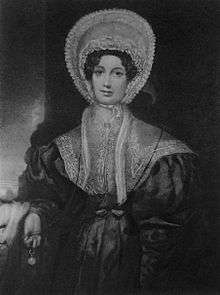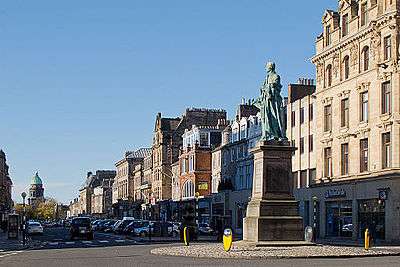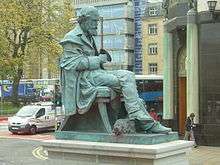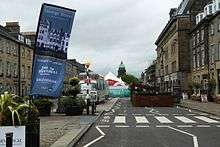George Street, Edinburgh
_p.073_-_George_Street%2C_St_Andrew's_Church%2C_and_Lord_Melville's_Monument%2C_Edinburgh_-_Thomas_Hosmer_Shepherd.jpg)
_p.157_-_St_George's_Church%2C_from_George_Street%2C_looking_West%2C_Edinburgh_-_Thomas_Hosmer_Shepherd.jpg)
George Street is the central thoroughfare of the First New Town of Edinburgh, planned in the 18th century by James Craig.[1]
The street takes its name from King George III[2] and connects St Andrew Square in the east with Charlotte Square in the west. It is located on the north side of the Old Town of Edinburgh, to the north of the Princes Street and to the south of Queen Street, running straight along the high point of a ridge.
George Street, as first proposed in 1767 and initially built, was a residential area.[2] However in the Victorian period the houses were replaced by shops, showrooms, banks, small department stores and hotels.[3] A number of the grander of these buildings were designed by the prominent Victorian architect David Bryce, who lived in the street.
George Street in the 21st century remains essentially a Victorian townscape, but the use of many of the commercial buildings has changed to restaurants, coffee shops and bars, with many high quality clothes shops.
Notable buildings, listed by address

- 13 - St Andrew's and St George's West Church (formerly St Andrew's Church), which dates from 1784.
- 14 - The Dome, originally designed by David Rhind and built in 1847 as the headquarters of the Commercial Bank of Scotland. This is on the site of James Craig's Physicians' Hall, built for the Royal College of Physicians of Edinburgh in 1781 and demolished c. 1843.[4]
- 15-17-19 - Caledonian Insurance Company designed by David Bryce in 1839-1840. Rebuilt in 1879-1880 when number 19 became part of the George Hotel.[5]
- 19-21 - The George Hotel, now renamed the Principal, established in 1881, combining Bryce's building and five townhouses dating back to 1775.
- 22-24-26 - The Royal Society of Edinburgh, occupying a building that was formerly owned by the Edinburgh Life Assurance Company.
- 25 - home of the novelist Susan Ferrier from 1784 to circa 1830.[6]
- 44 - Trotters Opticians, restored to a 'period' appearance in 1985.
- 54 - Assembly Rooms, which opened in 1787.
- 62-64-66 - former Union Bank of Scotland, designed by David Bryce in 1876.
- 80 - formerly the Professional and Civil Service Supply Association department store
- 84 - Northern Lighthouse Board.
- 89 - formerly Gray's of Edinburgh hardware shop, which closed in 2010 after moving to the site in 1903.[7]
- 96 - Freemasons' Hall, the headquarters of Scottish Freemasonry [8]
- 101-103 - former Bank of Scotland branch.
- 120 - modernist building for Cleghorn & Co, leather goods shop erected in 1924-25
- 121 - The headquarters of the Church of Scotland
- 131 - former residence of the architect David Bryce
Statues

Statues are located at vantage points along the street, depicting the prominent churchman Thomas Chalmers (1780–1847, erected in 1878, at the intersection with Castle Street), the British prime minister William Pitt the Younger (1759–1806, statue from 1831-3, at the intersection with Frederick Street), King George IV (1762–1830, reigned 1820–1830, statue made to commemorate his visit to Scotland in 1822, at the intersection with Hanover Street), and the Scottish scientist James Clerk Maxwell (1831–1879, statue dating from 2008, at the eastern end of George Street, near St Andrew Square).
Recent history
During construction work for the Edinburgh Trams project in 2011 and 2012, George Street became an important diversionary route as the parallel Princes Street was closed to traffic;[9] a survey in April 2012, during the works, found that footfall on the street was one-third higher than during the same month in 2011, while footfall in Princes Street had declined.[10] [2] By 2013 it had become, according to the Edinburgh Evening News, "the city’s most prestigious shopping district".[11]
In October 2012, the City of Edinburgh Council approved a 12-month trial starting in June 2014 that saw George Street featuring a one way system for vehicles, and a dedicated two way bike lane. As part of this the outdoor space for restaurants and bars on this street was extended, too. On street car parking was being reviewed, and the frequency of buses on Princes street was reduced significantly.[12] The trial used an Experimental Traffic Regulation Order (ETRO) as a place making and design measure. At the end of a trial the street was returned to its previous layout before the long-term plan was put to the public.[13] Ironside Farrer conducted a consultation and proposed a "continental style" solution in their report.[14] This report was discussed by the council on 7 June 2016 and the design principles approved unanimously.[15] The council agreed that a more detailed design was to be drawn up by February 2017 covering issues around traffic flow, transport users, the built streetscape including the statues, and pedestrians.[16]
During the Edinburgh Festival

In 2013 the street became a focal point for the Edinburgh Festival, with pedestrian areas increased and traffic space reduced.[11][17]
During the August 2016 festival period a new event, WestFest, took place on the most westerly block of George Street, which was closed to traffic between Castle Street and Charlotte Square. The event featured a whisky experience, a mobile cinema and 9-hole mini golf as well as a temporary cafe and bar.[18] Most of the George Street restaurants had extra outdoor seating during the event.
Gallery
_p.124_-_Physicians'_Hall%2C_George_Street%2C_Edinburgh_-_Thomas_Hosmer_Shepherd.jpg) Physicians' Hall, George Street, circa 1829
Physicians' Hall, George Street, circa 1829_p.111_-_Assembly_Rooms%2C_George_Street%2C_Edinburgh_-_Thomas_Hosmer_Shepherd.jpg) Assembly Rooms, George Street, circa 1829
Assembly Rooms, George Street, circa 1829_(14597149789).jpg) George Street in 1881
George Street in 1881.jpg) Statue in the Assembly Rooms
Statue in the Assembly Rooms Chandelier in the Assembly Rooms, George Street
Chandelier in the Assembly Rooms, George Street Edinburgh - St Andrew & St George Church
Edinburgh - St Andrew & St George Church.jpg) Statue of George IV at the intersection of George Street and Hanover Street
Statue of George IV at the intersection of George Street and Hanover Street Statue of Thomas Chalmers, at the intersection of George Street and Castle Street
Statue of Thomas Chalmers, at the intersection of George Street and Castle Street- David Bryce's bank building, on the corner of Hanover Street and George Street
 The Royal Society
The Royal Society- The Dome, formerly the Commercial Bank of Scotland
 Statue of James Clerk Maxwell by Alexander Stoddart dating from 2008, at the east end of George Street.
Statue of James Clerk Maxwell by Alexander Stoddart dating from 2008, at the east end of George Street. George Street, Edinburgh, December 2009
George Street, Edinburgh, December 2009.jpg) George Street in 2011, with London-style shop fronts on historic buildings
George Street in 2011, with London-style shop fronts on historic buildings George St, Edinburgh, closed to traffic during the WestFest trial.
George St, Edinburgh, closed to traffic during the WestFest trial. George Street, Edinburgh, during the August festival period 2015.
George Street, Edinburgh, during the August festival period 2015. George Street during the Edinburgh Festival in August 2018
George Street during the Edinburgh Festival in August 2018
References
- ↑ "George Street". Gazetteer for Scotland. Retrieved 23 March 2013.
- 1 2 3 History george-street.com
- ↑ George Street, on Edinburgh World Heritage website
- ↑ A history of James Craig's hall for the Royal College of Physicians of Edinburgh, A Lewis, Royal College of Physicians of Edinburgh Journal, Volume 38: Issue 2: 2008
- ↑ Caledonian Insurance Company, Scottish Architects website
- ↑ Corvey 'Adopt an Author': Susan Edmonstone Ferrier
- ↑ Grays of Edinburgh to close after 190 years, DIY Week, 2 September 2009
- ↑ Grand Lodge of Scotland official website
- ↑ Tram work diversions due to start in Edinburgh BBC News, 16 September 2011
- ↑ Princes Street set to reopen to traffic after 10 months The Herald, 26 June 2012
- 1 2 Morrison, Dawn (3 August 2013) Edinburgh Fringe descends on George Street Edinburgh Evening News
- ↑ http://news.stv.tv/east-central/246056-one-way-system-on-george-street-edinburgh-to-be-part-of-12-month-trial/
- ↑ CEC News Centre (11 August 2015). "Help shape the future of George Street layout". City of Edinburgh Council. Edinburgh City Council. Retrieved 21 August 2016.
- ↑ Ferguson, Brian (6 Feb 2016). "Continental makeover planned for Edinburgh's George Street". Edinburgh Evening News. Retrieved 21 August 2016.
- ↑ "George Street Experimental Traffic Regulation Order, Concluding Report and Design Principles". City of Edinburgh Council. CEC Transport and Environment Committee. 7 June 2016. Retrieved 21 August 2016.
- ↑ Stephen, Phyllis (28 July 2016). "The future of George Street will be drawn up by next year". The Edinburgh Reporter. The Edinburgh Reporter. Retrieved 21 August 2016.
- ↑ Edinburgh Festival: George Street to undergo revamp BBC News, 4 July 2013
- ↑ "WestFest". Essential Edinburgh. Essential Edinburgh. Missing or empty
|url=(help);|access-date=requires|url=(help)
External links
| Wikimedia Commons has media related to George Street, Edinburgh. |